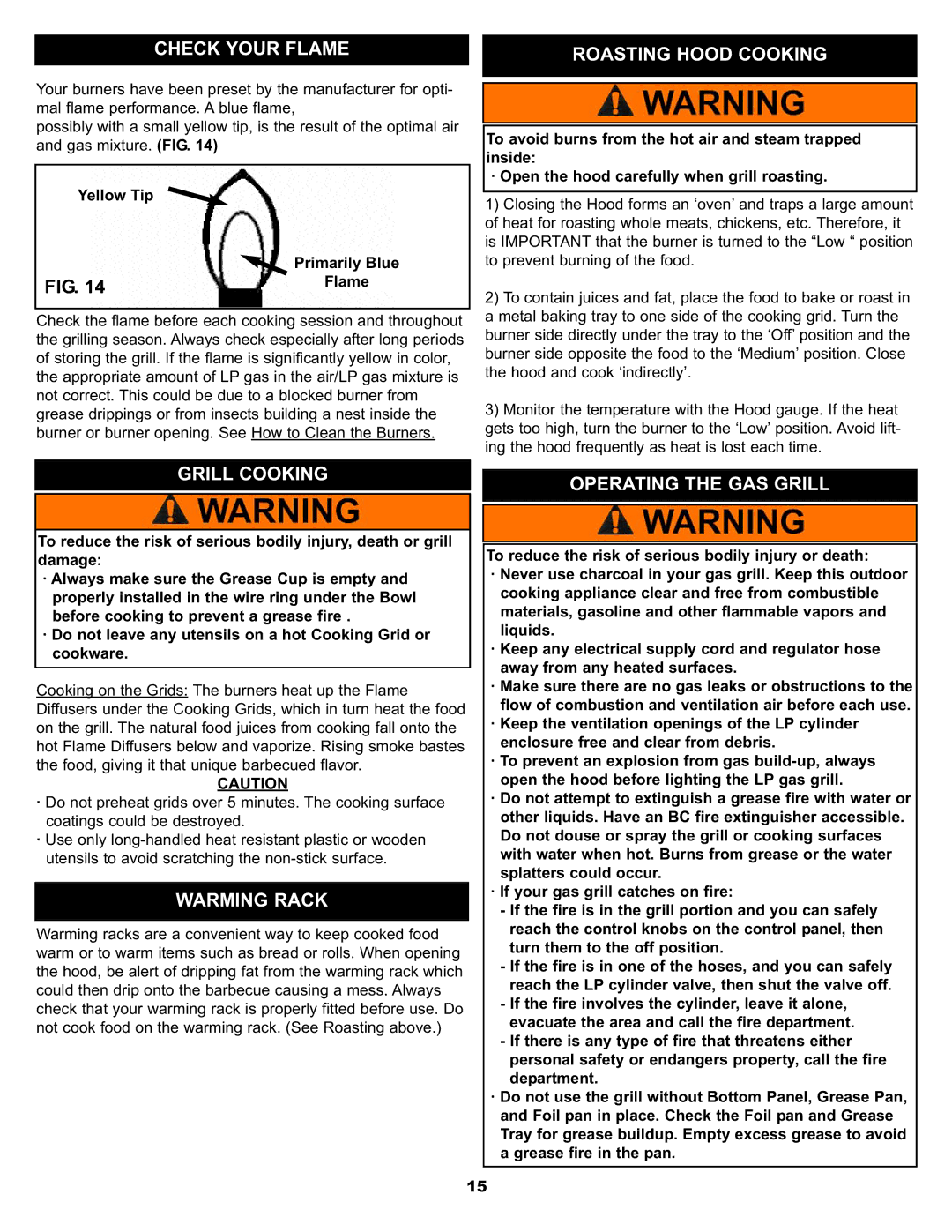
CHECK YOUR FLAME
ROASTING HOOD COOKING
Your burners have been preset by the manufacturer for opti- mal flame performance. A blue flame,
possibly with a small yellow tip, is the result of the optimal air and gas mixture. (FIG. 14)
Yellow Tip 
|
| Primarily Blue |
|
| Flame |
FIG. 14 |
| |
|
| |
| ||
|
|
|
Check the flame before each cooking session and throughout the grilling season. Always check especially after long periods of storing the grill. If the flame is significantly yellow in color, the appropriate amount of LP gas in the air/LP gas mixture is not correct. This could be due to a blocked burner from grease drippings or from insects building a nest inside the burner or burner opening. See How to Clean the Burners.
To avoid burns from the hot air and steam trapped inside:
· Open the hood carefully when grill roasting.
1)Closing the Hood forms an ‘oven’ and traps a large amount of heat for roasting whole meats, chickens, etc. Therefore, it is IMPORTANT that the burner is turned to the “Low “ position to prevent burning of the food.
2)To contain juices and fat, place the food to bake or roast in a metal baking tray to one side of the cooking grid. Turn the burner side directly under the tray to the ‘Off’ position and the burner side opposite the food to the ‘Medium’ position. Close the hood and cook ‘indirectly’.
3)Monitor the temperature with the Hood gauge. If the heat gets too high, turn the burner to the ‘Low’ position. Avoid lift- ing the hood frequently as heat is lost each time.
GRILL COOKING
OPERATING THE GAS GRILL
To reduce the risk of serious bodily injury, death or grill damage:
·Always make sure the Grease Cup is empty and properly installed in the wire ring under the Bowl before cooking to prevent a grease fire .
·Do not leave any utensils on a hot Cooking Grid or cookware.
Cooking on the Grids: The burners heat up the Flame Diffusers under the Cooking Grids, which in turn heat the food on the grill. The natural food juices from cooking fall onto the hot Flame Diffusers below and vaporize. Rising smoke bastes the food, giving it that unique barbecued flavor.
CAUTION
·Do not preheat grids over 5 minutes. The cooking surface coatings could be destroyed.
·Use only
WARMING RACK
Warming racks are a convenient way to keep cooked food warm or to warm items such as bread or rolls. When opening the hood, be alert of dripping fat from the warming rack which could then drip onto the barbecue causing a mess. Always check that your warming rack is properly fitted before use. Do not cook food on the warming rack. (See Roasting above.)
To reduce the risk of serious bodily injury or death:
·Never use charcoal in your gas grill. Keep this outdoor cooking appliance clear and free from combustible materials, gasoline and other flammable vapors and liquids.
·Keep any electrical supply cord and regulator hose away from any heated surfaces.
·Make sure there are no gas leaks or obstructions to the flow of combustion and ventilation air before each use.
·Keep the ventilation openings of the LP cylinder enclosure free and clear from debris.
·To prevent an explosion from gas
·Do not attempt to extinguish a grease fire with water or other liquids. Have an BC fire extinguisher accessible. Do not douse or spray the grill or cooking surfaces with water when hot. Burns from grease or the water splatters could occur.
·If your gas grill catches on fire:
-If the fire is in the grill portion and you can safely reach the control knobs on the control panel, then turn them to the off position.
-If the fire is in one of the hoses, and you can safely reach the LP cylinder valve, then shut the valve off.
-If the fire involves the cylinder, leave it alone, evacuate the area and call the fire department.
-If there is any type of fire that threatens either personal safety or endangers property, call the fire department.
·Do not use the grill without Bottom Panel, Grease Pan, and Foil pan in place. Check the Foil pan and Grease Tray for grease buildup. Empty excess grease to avoid a grease fire in the pan.
15
